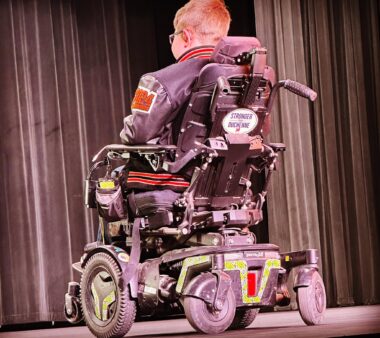Confronting the past as my oldest son takes senior-year pictures
What a change between one portrait of a Duchenne teen and another

The first time the words “Duchenne muscular dystrophy” (DMD) were spoken to me, they might as well have been in a whisper. I could barely comprehend the specialist sitting across from me who was saying something was wrong with Max, my beautiful, oldest son.
I remember asking questions, although I’m still determining how I managed it. I wanted to know how to spell Duchenne because I’d never heard of it before, even after the neurologist said, “You know? Jerry Lewis’ kids?” I still had no idea.
Max was diagnosed with DMD that day. I asked if my other sons would have it, too. Those following my column know that two of my other three sons, Rowen and Charlie, were diagnosed within months.
I left the doctor’s office that first day with a folder and a letter to parents of children who were recently diagnosed with DMD. I distinctly remember a picture of an older guy with Duchenne. He was probably about the same age that Max is now: 17.
The picture accompanied a piece of literature encouraging parents to stay positive. It showed a good-looking kid, but the picture made me feel sick.
I’m hurt and embarrassed to admit it, but I had trouble seeing a young man in a wheelchair just moments after someone told me my son would die from DMD. But that’s my good-looking kid now, and it hurts to think others might feel the way I did.
I couldn’t imagine my then 4-year-old son ever looking like that kid pictured in a wheelchair. Not when Max could walk. Not when he was born healthy. It was so much to comprehend, and my mind couldn’t accept that my son would someday look like that.
And it didn’t get better, not right away. I didn’t show my sons pictures of older boys with DMD because, at least at first, I was afraid for them to see those older guys. I was worried they’d scare my sons. Max, Rowen, and Charlie, however, were never frightened. They were impressed by the chairs and the service dogs, yes, but scared? Never!
I learned from my sons. The wheelchair doesn’t take away, but gifts them precious abilities.
Years passed. The disease progressed, and we saw changes. The boys got chairs. They’re now the handsome kids who could accompany a letter about the goodness that a life with Duchenne still holds.
Max is graduating from high school this year. When my oldest child — Lexi, now 22 — graduated high school, she looked forward to senior pictures, and we shopped for clothes and planned the shoot. It seemed like a normal part of senior year.
For some reason, I didn’t experience that preparation with Max. Perhaps, as I’d been told, that was because he’s a boy, and they don’t get as excited. But I worried that maybe it was me. Perhaps I was afraid to see what scared me so many years ago.
I’m happy to share that I quickly realized those worries weren’t the case; it was indeed simply because Max is a boy. He didn’t see the point and would gladly have skipped the pictures altogether.
He’d agree to only three outfits, not the four in the picture package I bought. I got to pick two of them, and he picked one. I found a creative photographer I knew would be excellent because, let’s admit it, the wheelchair adds difficulty.
Thankfully, the pictures turned out fantastic. If you want to see my handsome son, follow me on social media because I can’t stop sharing them. He’s one of the best things I’ve ever seen. He’s resilient, happy, successful, and excited for the future.
I realize that parents of young boys diagnosed today might feel just as I did. But I hope they don’t linger there as long as me because life is too extraordinary to put on hold until you’re ready.
I end this column by sharing a picture with you. I encourage you to consider the magnet on the back of Max’s chair, which reads “Stronger than Duchenne.” That’s all that needs to be said.

Betty Vertin’s son Max, 17, at the taking of his pictures as a high school senior. The magnet on the back of his chair reads “Stronger than Duchenne.” (Photo by Betty Vertin)
Note: Muscular Dystrophy News Today is strictly a news and information website about the disease. It does not provide medical advice, diagnosis, or treatment. This content is not intended to be a substitute for professional medical advice, diagnosis, or treatment. Always seek the advice of your physician or another qualified health provider with any questions you may have regarding a medical condition. Never disregard professional medical advice or delay in seeking it because of something you have read on this website. The opinions expressed in this column are not those of Muscular Dystrophy News or its parent company, Bionews, and are intended to spark discussion about issues pertaining to muscular dystrophy.








Leave a comment
Fill in the required fields to post. Your email address will not be published.